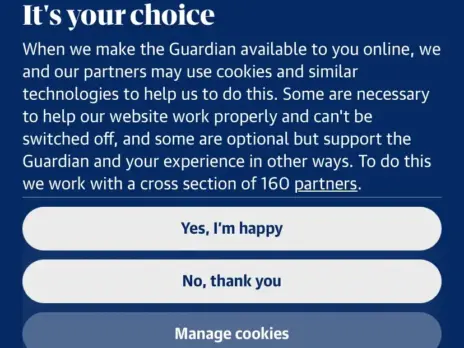Yes, I know. This kind of exercise has been done before. But mostly in the US. (If a similar exercise exists for UK markets, apologies: send me a link and I’ll append it to the bottom of this post.) In any event: given Rupert Murdoch’s enthusiasm for paywalls, I wanted to figure out what Times Online might generate by erecting a paywall around its entire site. Here goes. . .
How big is the online user base of The Times? ABCE suggests that the paper’s site attracted 1.15 unique users on an average day during March 2009.
Certainly, some overseas visitors to The Times might want to purchase subscriptions if the paper’s content were placed behind a paywall. But not many. So for the moment, let’s strip out these overseas visitors (they account for 62.4% of unique users at Times Online).
According to ABCE data, this leaves us with an average of 433,236 daily UK-based unique users.
A recent survey by New Media Age suggested that 12% of consumers would ‘pay to read a newspaper online”.
The number might be higher for The Times (because its users are de facto more interested in news than the general population). Or it might be lower (because older readers are less willing to pay for online content).
So let’s stick with 12%. Notionally, we’re therefore looking at 51,988 UK-based readers who might be tempted to pay to read Times Online on a daily, or near daily, basis.
How much would they pay? According to survey data from PWC, users are willing to pay 62% of the cost of a paper edition for access to ‘high quality news content online”.
At first glance, this seems rather high to me. But interestingly, the proportions are roughly similar to those charged by the FT and FT.com. The FT, for example, charges £312 for a year’s print subscription (picked up at the newsagents) and £207 for standalone online access.
So let’s proceed on the basis that subscribers to Times Online would buy access at 62% of the cost of a print subscription.
A print subscription for The Times (and Sunday Times) currently costs £286 a year (picked up at the newsagents). In theory, then, the right pricing point for an annual subscription to Times Online should be something like £177.
At this point, however, let’s zero in upon the preferences of those potential paying punters, as outlined by New Media Age. As I’ve said, only 12% of consumers said they might pay. But of these, the vast majority — 77% — would prefer to read stories on a pay as you go basis (presumably making micropayments along the way).
Only 23% of potential payees would be willing to sign up for online subscriptions. Apply this to Times Online, and the potential subscription revenue base that emerges is £2.2m.
Of course, PAYG readers making micropayments will be worth something. But how much?
As it happens, one of the best places to go looking for comparisons between subscribers and PAYG customers is the mobile industry. Data from Vodafone suggests that the operator’s average PAYG user is worth around 78% less than contract customers to the company on a monthly basis.
Our model suggests that Times Online might attract 40,030 PAYG users within the UK. Using Vodafone’s data, we can speculate that each of these users might be worth £38.37 a year to Times Online.
The annualised revenue potential for PAYG micropayments therefore emerges at £1.54m per year.
At this point, we’re in a position to guess at the size of the potential revenue gain if Times Online required its UK readers to pay for access. It’s around £3.74m per year.
Of course, this figure is riddled with holes. They start with my use of ABCE data, which is subject to criticism on the basis of methodology (just like alternative numbers from Nielsen, comScore and Hitwise).
Equally, paywall enthusiasts might point out that I’m not making any provision for News International’s ability to sell subscriptions to overseas users. Or its ability to sell advertising at premium rates against highly-engaged subscribing readers.
It’s conceivable, I suppose, that doing both of these things successfully could double the size of the potential annual revenue base at Times Online to a chunkier £7m-£8m.
This sounds better. It’s also worth noting that this revenue should be highly profitable. After set-up costs, the cost base required to support these subscriptions won’t be huge. But we still need to take a look at three numbers that really count for the purposes of comparison.
The first is the £444.8m overall revenue generated by Times Newspapers Ltd, publisher of The Times and Sunday Times, during 2008. The second is the size of the loss that Times Newspapers made on that revenue: £51.3m.
Both of these numbers make the potential for reader revenues at Times Online look puny.
The third number is a bit more speculative, but worth thinking about. If Times Newspapers resembles its peers, around 10% of its revenues last year might have been generated by digital advertising.
Call it £45m. This is a large amount of revenue to risk if the potential gain from exploiting a paywall around its main site amounts to £8m a year.
No: the evidence all points one way. When News International and Guardian Media Group erect paywalls, they will do so around augmented strands of premium content like sport, food, health, media, education. They’ll use their main sites to drive potential subscribers through paywalls into those vertical mini-sites.
My first suspicion is that this could work well. My second suspicion is that magazine publishers could become big casualties of this landgrab.
In consumer markets, many have been slow to embrace the web. In B2B, some lack the resources to publish decent sites. In both respects, the lesson is clear. The magazine industry needs to pull its finger out before digital territory that it should already dominate gets annexed by outsiders.
Email pged@pressgazette.co.uk to point out mistakes, provide story tips or send in a letter for publication on our "Letters Page" blog






